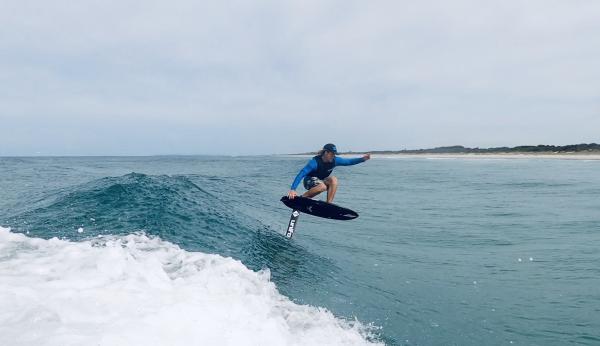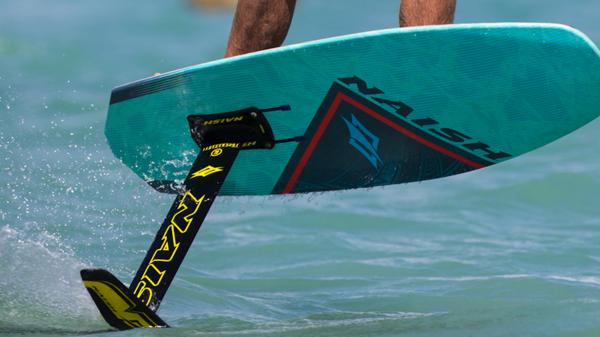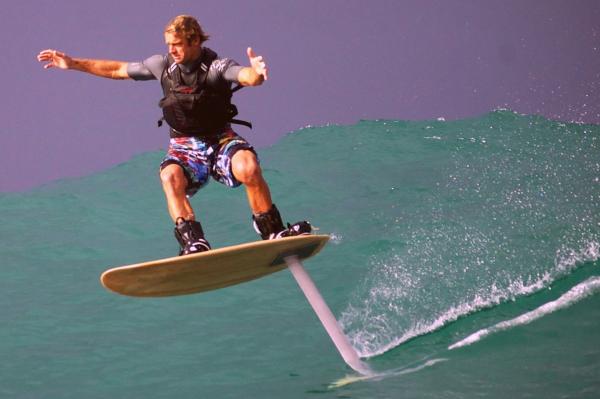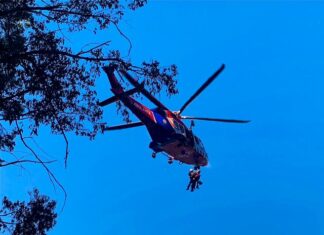“I looked behind me as I flicked off the wave and all I could see was what looked like a surfboard with a machete attached to its bottom bearing down on me. It was very frightening.”So said one surfing veteran after a holiday season session riding excellent waves on Noosa’s outer bays earlier this month. Another described them as the “silent assassins of the surf”.
Although the popularity of high performance, fast-moving but unpowered hydrofoil (or foil) boards has been growing in Noosa for several years, users have mostly restricted themselves to the beach breaks of Noosa West and the Eastern Beaches where they could find space to themselves for their high-speed runs. But the perfect storm of an easterly swell creating consistently good waves on the points, while a strong south-east wind made the beach breaks unattractive, and Covid-19 almost doubling the number of surf tourists in the water created a succession of frightening near misses reported from both Tea Tree Bay and Granite.
In response to these growing concerns about the number of foil surfers now using the most popular breaks within the Noosa World Surfing Reserve, the stewardship council for the Noosa Reserve will help co-ordinate a round-table conference of surfers and stakeholders next month (February).
In a statement released last Friday, the NWSR stewardship council emphasised that the Reserve “did not seek to ban foils or any other surfcraft, but hoped to achieve a consensus view on how to introduce controls in the interests of public safety before the matter is taken out of the hands of the surfing community.”After consultation with the Noosa Boardriders Club, the Noosa Malibu Club, Noosa Heads Surf Lifesaving Club, Noosa Council and Maritime Safety Queensland, it was decided that a round-table meeting offered the best chance of finding a self-regulated solution.
It’s now two years since Sydney’s Waverley Council took one look at the emerging danger at Australia’s highest density beach, Bondi, and banned foils outright. But this wasn’t the first high density surfing region to ban them. The city of Anglet, just north of Biarritz on the Atlantic coast of France, banned them in 2018.According to one Bondi source, local foil surfers, such as former world tour professional Perth Standlick, have more or less accepted the ban, while reaching an unofficial compromise position with lifeguards that offers a blind eye turned to sessions on outside peaks on wild days when there are very few others in the water.Speaking as a lifetime surfer who grew up in the era of council surfboard registration and Draconian board confiscation for any alleged infringements, this writer doesn’t want to see a blanket ban on any kind of surfcraft in Noosa, particularly of the unpowered variety.
I even have a soft spot for foils, having first seen them ridden with grace and fluidity by Hawaiian surfers Titus Kinimaka, Brian Keaulana and Dave Kalama (despite the big ungainly boots they wore back then) in huge waves in France more than 20 years ago. Later, former Noosan Chris de Aboitiz, Woogie Marsh, Guy Schroeder and other talented watermen pioneered their use here, and Chris’s son, the multiple world kitesurfing champion Keahi de Aboitiz, is one of the leading exponents in the world today. Few people would argue that there is no place for the foil in the surfing culture; it is more a matter of defining where that place is.The NWSR stewardship council has already sought the views of experienced foil surfers and and is in discussion with various authorities about control mechanisms available outside the declared Noosa Bathing Reserve, as the proposed State government legislation for the protection of World Surfing Reserves in Queensland comes back onto the agenda in the coming weeks.
Although electric-powered foil boards are currently being rented and used in the river system, with lessons and tours on offer, the emerging technology has not yet seen the craft classified as a vessel, allowing considerable freedoms in their use. But surfing foils, powered only by their own hydrodynamics and the energy of the rider, are also capable of very high speed runs with a sharp blade edge exposed between the board and the water.In the right hands and in the right places, these are highly creative and legitimate surfcraft. In the tight take-off zone of a crowded point break, they are potentially lethal. That’s the concern of the Noosa World Surfing Reserve and other key stakeholders.









